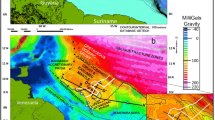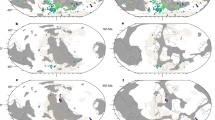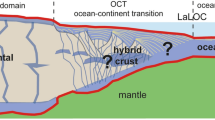Abstract
Oceanic crust formed over the past 30 million years at the Australian–Antarctic discordance (AAD) is characterized by chaotic sea-floor topography, reflecting a weak magma supply from an unusually cold underlying mantle. During the past 3–4 million years, however, a source of increased magma supply, coinciding with the known Indian–Pacific mantle isotopic boundary, has propagated into the eastern AAD, displacing the chaotic terrain and replacing it with normal sea floor. Pacific mantle reached the eastern boundary of the AAD at least 7 million years ago, but it was not until 3–4 million years ago that lavas derived from Pacific mantle were first erupted within the AAD. This long hiatus, combined with the ridge–transform geometry across the AAD boundary, constrains the locus of mantle migration to a narrow, relatively shallow region, directly beneath the spreading axis of the Southeast Indian ridge.
This is a preview of subscription content, access via your institution
Access options
Subscribe to this journal
Receive 51 print issues and online access
$199.00 per year
only $3.90 per issue
Buy this article
- Purchase on Springer Link
- Instant access to full article PDF
Prices may be subject to local taxes which are calculated during checkout






Similar content being viewed by others
References
Weissel, J. K. & Hayes, D. E. The Australian-Antarctic Discordance; new results and implications. J.Geophys. Res. 79, 2579–2587 (1974).
Forsyth, D. W., Ehrenbard, R. L. & Chapin, S. Anomalous upper mantle beneath the Australian-Antarctic Discordance. Earth Planet. Sci. Lett. 84, 471–478 (1987).
Marks, K., Vogt, P. R. & Hall, S. A. Residual depth anomalies and the origin of the Australian-Antarctic Discordance. J. Geophys. Res. 95, 17325–17337 (1990).
West, B. P., Sempéré, J.-C., Pyle, D. G., Phipps Morgan, J. & Christie, D. M. Evidence for variable upper mantle temperature and crustal thickness in and near the Australian-Antarctic Discordance. Earth Planet Sci. Lett. 128, 135–153 (1994).
Palmer, J., Sempéré, J.-C., Christie, D. M. & Morgan, J. P. Morphology and tectonics of the Australian-Antarctic Discordance between 123° E and 128° E. Mar. Geophys. Res. 15, 121–152 (1993).
Sempéré, J.-C., Palmer, J., Christie, D., Morgan, J. P. & Shor, A. Australian-Antarctic Discordance. Geology 19, 429–432 (1991).
Sempéré, J.-C., West, B. P. & Géli, L. in Tectonic, Magmatic, Hydrothermal and Biological Segmentation of Mid-ocean Ridges(eds MacLeod, C. J., Tyler, P. A. & Walker, C. A.) 1–5 (Geol. Soc., London, (1996)).
West, B. P. Mantle flow and crustal accretion in and near the Australian Antarctic Discordance. Ph.D. thesis.University of Washington, Seattle.(1997).
Klein, E. M., Langmuir, C. H., Zindler, A., Staudigel, H. & Hamelin, B. Isotope evidence of a mantle convection boundary at the Australian-Antarctic Discordance. Nature 333, 623–629 (1988).
Pyle, D. G., Christie, D. M. & Mahoney, J. J. Resolving an isotope boundary within the Australian-Antarctic Discordance. Earth Planet. Sci. Lett. 112, 161–178 (1992).
Hey, R. N., Sinton, J. M. & Duennebier, F. K. in The Geology of North America: The Eastern Pacific Ocean and Hawaii(eds Winterer, E. L., Hussong, D. M. & Decker, R. W.) 161–176 (Geol. Soc. Am., Denver, CO, (1989)).
Blackman, D. K., Cann, J. R. & Janssen, B. The structure of oceanic core complexes: new observations from the Mid-Atlantic Ridge at Atlantis transform fault. Eos 78, F663 (1997).
Tuckholke, B. E., Lin, J. & Kleinrock, M. C. Relation between rift-axis magmatism, frequency of detachment faulting and development of inside-corner highs in slow-spreading crust. Eos 78, F663 (1997).
Pyle, D. G. Geochemistry of mid-ocean ridge basalt within and surrounding the Australian Antarctic Discordance. Ph.D. thesis. (Oregon State University, Corvallis. (1994)).
Cann, J. R.et al. Corrugated slip surfaces formed at ridge-transform intersections on the Mid-Atlantic Ridge. Nature 385, 329–332 (1997).
Cannat, M. Emplacement of mantle rocks in the seafloor at mid-ocean ridges. J. Geophys. Res. 98, 4163–4172 (1993).
Cannat, M. How thick is the magmatic crust at slow spreading oceanic ridges? J. Geophys. Res. 101, 2847–2857 (1996).
Karson, J. A. & Elthon, D. Evidence for variations in magma production along oceanic spreading centers: a critical appraisal. Geology 15, 127–131 (1987).
Bonatti, E. Anomalous opening of the Equatorial Atlantic. Earth Planet. Sci. Lett. 143, 147–160 (1996).
Tucholke, B. E. & Lin, J. Ageological model for the structure of ridge segments in slow-spreading ocean crust. J. Geophys. Res. 99, 11937–11958 (1994).
Madsen, J. A., Grindlay, N. R., Rommeveaux, C. & Sclater, J. Morphologic characteristics of ridge segments along the Southwest Indian Ridge, 15–35 degrees E. Eos 77, F671 (1996).
Grindlay, N. R., Madsen, J. A., Rommeveaux, C. & Sclater, J. Segmentation of the Southwest Indian Ridge, 15–25° E. Eos 77, F672 (1996).
Klein, E. M. & Karsten, J. L. Ocean-ridge basalts with convergent-margin geochemical affinities from the Chile Ridge. Nature 374, 52–57 (1995).
Dick, H. J. B. in Magmatism in the Ocean Basins(eds Saunders, A. D. & Norry, M. J.) 71–105 (Geol. Soc., London, (1989)).
Schilling, J.-G. Iceland mantle plume: Geochemical evidence along Reykjanes Ridge. Nature 242, 565–571 (1973).
Schilling, J.-G., Kingsley, R. H. & Devine, J. D. Galapagos hot spot-spreading center system 1. spatial petrological and geochemical variations (83° W–101° W). J. Geophys. Res. 87, 5593–5610 (1982).
Schilling, J.-G. Upper mantle heterogeneites and dynamics. Nature 314, 62–67 (1985).
Mahoney, J. J.et al. Isotope and tracer element characteristics of a super-fast spreading ridge: East Pacific Rise, 13–23° S. Earth Planet. Sci. Lett. 121, 173–193 (1993).
Mahoney, J. J.et al. Isotopic and geochemical provinces of the western Indian Ocean spreading centers. J. Geophys. Res. 94, 4033–4052 (1989).
Pyle, D. G., Christie, D. M., Mahoney, J. J. & Duncan, R. A. Geochemistry and geochronology ofancient southeast Indian and southwest Pacific seafloor. J. Geophys. Res. 100, 22261–22282 (1995).
Lanyon, R., Crawford, A. J. & Eggins, S. M. Westward migration of Pacific Ocean upper mantle into the Southern Ocean region between Australia and Antarctica. Geology 23, 511–514 (1995).
West, B. P., Wilcock, W. S. D., Sempéré, J.-C. & Géli, L. Three-dimensional structure of asthenospheric flow beneath the Southeast Indian Ridge. J. Geophys. Res. 102, 7783–7802 (1997).
Anderson, R. N., Spariosu, D. J., Weissel, J. K. & Hayes, D. E. The interrelation between variations in magnetic anomaly amplitudes and basalt magnetization and chemistry along the Southeast Indian Ridge. J. Geophys. Res. 85, 3883–3898 (1980).
Hayes, D. E. & West, J. K. Depth anomalies in the Southeast Indian Ocean (abstr.). Geol. Soc. Am. Abstr. Programs 6, 784 (1974).
Gurnis, M., Müller, R. D. & Moresi, L. Cretaceous vertical motion of Australia and the Australian-Antarctic Discordance. Science 279, 1499–1504 (1998).
Anderson, R. N., Spariosu, D. J., Weissel, J. K. & Hayes, D. E. The interrelation between variations in magnetic anomaly amplitudes and basal magnetization and chemistry along the Southeast Indian Ridge. J. Geophys. Res. 85, 3883–3898 (1980).
Klein, E. M., Langmuir, C. H. & Staudigel, H. Geochemistry of basalts from the Southeast Indian Ridge, 115° E–138° E. J. Geophys. Res. 96, 2089–2107 (1991).
Alvarez, W. Geological evidence for the geographical pattern of mantle return flow and the driving mechanism of plate tectonics. J. Geophys. Res. 87, 6697–6710 (1982).
Alvarez, W. Geologic evidence for the plate driving mechanism: the continental undertow hypothesis and the Australian-Antarctic Discordance. Tectonics 9, 1213–1220 (1990).
Crawford, A. J., Briquieu, L., Laporte, C. & Hasenaka, T. Coexistence of Indian and Pacific Oceanic Upper Mantle Reservoirs Beneath the Central New Hebrides Island Arc 199–217 (AGU Monogr. 88, Am. Geophys. Union, Washington, DC, (1995)).
Hergt, J. M. & Hawkesworth, C. J. Pb, Sr and Nd isotopic evolution of the Lau Basin: Implications for mantle dynamics during backarc opening. Proc. ODP 135, 505–517 (1994).
West, B. P., Christie, D. M. Diversion of along-axis asthenospheric flow beneath migrating ridge-transform-ridge intersections. Eos 78, F673 (1997).
McKenzie, D. P. & Bowin, C. The relationship between bathymetry and gravity in the Atlantic Ocean. J. Geophys. Res. 81, 1903–1915 (1976).
Wessel, P. & Smith, W. H. F. Free software helps map and display data. Eos 72, 445–446 (1991).
Acknowledgements
This work was supported by the US NSF.
Author information
Authors and Affiliations
Corresponding author
Rights and permissions
About this article
Cite this article
Christie, D., West, B., Pyle, D. et al. Chaotic topography, mantle flow and mantle migration in the Australian–Antarctic discordance. Nature 394, 637–644 (1998). https://doi.org/10.1038/29226
Received:
Accepted:
Issue Date:
DOI: https://doi.org/10.1038/29226
This article is cited by
-
Large along-axis variations in magma supply and tectonism of the Southeast Indian Ridge near the Australian-Antarctic Discordance
Acta Oceanologica Sinica (2020)
-
An isotopically distinct Zealandia–Antarctic mantle domain in the Southern Ocean
Nature Geoscience (2019)
-
Distribution of large-scale detachment faults on mid-ocean ridges in relation to spreading rates
Acta Oceanologica Sinica (2013)
-
Widespread active detachment faulting and core complex formation near 13° N on the Mid-Atlantic Ridge
Nature (2006)
-
Water-rich basalts at mid-ocean-ridge cold spots
Nature (2005)
Comments
By submitting a comment you agree to abide by our Terms and Community Guidelines. If you find something abusive or that does not comply with our terms or guidelines please flag it as inappropriate.



